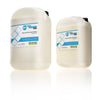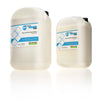How Calcium Affects The Printing Process
The paper industry's switch from acidic to alkaline paper, coupled with an increase in the pH and alkalinity of municipally supplied water, has created a new set of problems for today's printer. Many of these problems can be directly traced to the increased presence of calcium in the printing environment. In the following article we share our experience in observing, analyzing and solving these problems. The article covers:
- These new problems and how they can be recognized;
- Recommend steps which the printer can take to minimize their effect
- Cover the sources of calcium, and why paper and water are changing
- Discuss the role that fountain solution can play in minimizing calcium's effects.
These new problems and how they show up in the printing process.
Rollers
A uniform white haze develops on the surface of rollers in either the inking or dampening trains. This interferes with the ability of these rollers to carry uniform ink and/or water films, and leads to poor ink transfer, roller stripping or sensitive water rollers. In extreme cases, a hard band of white calcium compounds builds up at roller ends, and roller settings cannot be properly maintained.
Plates
Calcium compounds that deposit in the grain may lead to plate sensitivity (toning) that cannot be eliminated by increased water metering speeds or use of alkaline plate washes. Calcium compounds that deposit around or on plate surface dots can lead to plate blinding, where the image area will not accept ink.
Blankets
Calcium deposition on the blanket surface (a white haze which cannot easily be removed by plain water) interferes with the ability of the blanket to transfer ink properly and print a sharp dot with a clean background.
Water System
Fountain solution in pans, chillers and recirculation tanks may turn milky white because of the presence of large amounts of insoluble calcium compounds. Conductivity and pH may both rise dramatically due to contamination and destruction of the buffer system. The printer may not be able to keep the non-image areas clean despite increased water metering speeds. White or off-white deposits may accumulate in the bottom of press fountain pans that have poor drainage or exchange rates, reducing their effective volumes and possibly leading to fountain pan overflow.
How can the printer minimize these problems?
It is important to realize that not all alkaline paper and board is bad, and that changes in the water supply can be easily dealt with. The most important thing is to recognize the above symptoms so that no time is lost in implementing a solution. We can’t change the paper or incoming water supply, but by following these recommendations the printer can minimize the impact of increased calcium on the process.
Water
The use of reverse osmosis (RO) water ensures a consistent supply of water designed specifically for the printing process. Other treated water sources can have drawbacks:
- distilled water is very expensive; and
- softened water still contains undesirable alkalinity.
Reservoir Maintenance
Recirculation tanks should be drained ideally on a fortnightly basis and refilled with fresh fountain solution. At this time, press fountain pans should be cleaned if needed. Printers should monitor and record both pH and conductivity on a daily basis. If pH increases more than 0.5 units, or if conductivity increases more than 1000 mhos (1000 micro Siemens), versus initial readings, consider changing the fountain solution regardless of age. Otherwise, we recommend changing fortnightly. Periodically or as needed, the entire recirculation system should be drained and then flushed with Prisco Royal Flush to remove all contamination.
Fountain Solution
We’ll discuss them in more detail later. Normally, fountain solutions are selected based on water quality and type of press and dampening system. Type of stock may influence the choice, and in some cases a switch to obtain greater buffer capacity may be necessary.
Press Maintenance
The importance of a regular press roller maintenance program cannot be over-emphasized. Prisco roller maintenance products such as D-Glaze, Salt Crystal Remover and Alkaline Paper Roller Rinse are designed to remove calcium compounds from the roller train. Metering Roller Cleaner and Chrome Roller Cleaner will clean and desensitize rollers in the dampening system. Ceramic press rollers may be cleaned with an alkaline cleaner such as Prisco Heavy Duty Cleaner II.
Most calcium compounds are essentially insoluble in water and alkaline plate
cleaners. They are actually insoluble in acid-type fountain solutions as well. Calcium carbonate slowly reacts with the acid to yield calcium ions, which can combine with other ions such as citrate and phosphate, and precipitate out on rollers as a white haze or as hard, rock-like deposits.
Now that we have described the problem and how to minimize its effects, let's discuss the sources for calcium in today's printing environment, and how they contribute.
Water
All municipally supplied and well water contains at least some calcium. The amount can be determined by a very simple water hardness test. This test, however, does not measure total alkalinity, which is more important when selecting a fountain solution. Carbonate, which is alkaline, is the species which actually reacts with the acid in the fountain solution, raising its pH and using up buffer capacity. Conductivity usually, but not always, increases as hardness and alkalinity rise. These three properties—conductivity, hardness and alkalinity—are independent. A properly conducted water quality analysis always includes all three along with a pH determination.
Ink
It is well known that press units printing red inks tend to develop more calcium-related problems. Fountain solutions in these units may also experience sharp upward rises in pH and conductivity within a short period of time. Many red pigments in inks are calcium-based, and the constant mixing of fountain solution and ink on the press causes some of this calcium to be “leached out” by, and absorbed into, the fountain solution. Once there, it is free to react with other ions that are present, and can form hard, insoluble compounds.
Paper
In recent years most paper manufacturing has switched from an acid to an alkaline process. This is a less polluting, cheaper process that produces a better printing sheet that is more permanent. But it is also a process that introduces calcium carbonate into the printing environment. Very simply, paper consists of wood fibres, inorganic fillers and a material called sizing which acts like a glue to hold the insides of the sheet together. Coated paper, of course, has an outer layer, generally starch- or latex-based, which also contains fillers. Acid type paper uses 8-12% clay (an alumino-silicate) as the main filler along with a rosin-alum sizing. For this to function effectively, a pH of 4.5 to 5.5 is needed which results in a sheet with a residual acidic pH (acid paper). Calcium carbonate can’t be used because it would dissolve and cause foaming. Alkaline paper, on the other hand, is made under slightly alkaline (pH 7.5 to 8.5) conditions, uses an organic sizing, and accommodates higher amounts of filler—usually 15 to 25% calcium carbonate. Improper or insufficient sizing and/or poor coating can lead to piling and the release of calcium carbonate onto the blankets. Then, it can work its way back into the ink and dampening roller trains via the plates (remember, all these items are in continual high speed contact). Part of the fountain solution's job is to absorb this calcium carbonate. If too much comes out of the paper, the excess ends up on the rollers, plates and blankets.
The role fount solutions play in minimizing calcium-related problems?
The Prisco product line-up includes a wide variety of fountain concentrates for both soft-to-medium and hard water. Water that contains large amounts of calcium and/or alkalinity (generally 200ppm or more) requires use of a fountain concentrate with extra acid (a so-called "hot" etch); otherwise the starting pH will be too high. Carbonate alkalinity reacts with the acid in the fountain concentrate, raising its pH. All modern fountain solutions contain a buffer system which is designed to react with or absorb alkaline materials and maintain a constant pH. Buffer capacity differs from solution to solution, and sometimes a change has to be made to a solution, which has larger capacity.
Even if the printer has soft-to-medium water, either a "hot" or highly buffered fountain concentrate may be necessary, especially if he is printing large amounts of very alkaline or poorly sized paper which has poor water resistance. This type of paper may release more than the normal amount of calcium carbonate into the fountain solution.
Optimize Your Performance
We have seen how recent changes in paper manufacturing and municipal water supplies have resulted in calcium-related problems becoming more prevalent in the printing environment. We have also seen that these problems can be easily minimized through regular pressroom maintenance and by choosing the correct Priscoproducts. To help address your specific calcium-related problem-solving needs, we’ve assembled a Calcium Elimination Kit, which contains four proven Prisco product solutions:
- Salt Crystal Remover
- Chrome Roller Cleaner
- Eezy-Klene
- Royal Flush
Ask our technical representative for more information. With our products and services, we’ll help you optimize your performance on press.
Need to replenish your Process Ink or Litho Print Supplies?
We supply a full range of Print Consumables, including Van Son Process Inks, Standard Pantone Ink, Pantone Matching Guides, Litho Print Chemistry, Litho Printing Blankets and OverPrint Varnishes.
- Clive Harper






